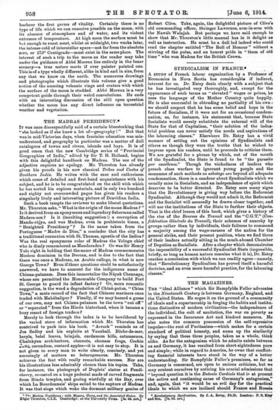A TRIP TO THE MOON"
MANY romancers have been attracted by the possibility of making a trip to the moon. Lucian and Cyrano de Bergerac invented only impossibilities. Poe's method was frankly meant to be farcical at the outset, though he was carried away by his vivid imagination, and gave us a fascinating hint of "the incomprehensible connexion between each par- ticular individual on the moon with some particular individual on the earth—a connexion analogous with, and depending upon, that of the orbs of the planet and the satellite, and by means of which the lives and destinies of the inhabitants of the one are interwoven with the lives and destinies of the inhabitants of the other." Jules Verne imagined a liege cannon which fired a shell big enough to bold three or four people, though they did not succeed by its means in landing on the moon. Mr. Wells thought that the trip to the moon could be managed in a sphere covered with a material opaque to gravitation ; only that has still to be invented. But there is in fact only one way by which we can approach the moon—and that is through a telescope. This was the method adopted in the famous American moon-hoax, and this is Abbe Moreux's way. His long study of the moon from his observatory at Bourges has familiarized him with every aspect of our satellite, and he has thrown his knowledge into the shape of an imaginary trip to the moon, where he describes all that a visitor would see in a fashion which combines picturesque vividness with scientific accuracy. There is indeed nothing so exciting 8£1 the human bat —Vesperlilio home—of the ingenious Mr. Locke. We know with absolute certainty that the moon is a dead world. A powerful modern telescope, under favourable conditions of atmosphere, enables us to distinguish any object that is as much as a hundred yards in diameter. "A great building like one of our cathedrals, a railway-station, a village, a regiment on the march, would therefore be quite visible. But no one has ever observed such signs of civilization." It is not even open to the imagination to suppose that life may exist on the permanently invisible half of the moon, or have taken refuge, as Mr. Wells suggests, in the hollow interior of our satellite. It is in the highest degree doubtful whether life of any kind ever came into existence on the moon, which split off from the earth ages before this planet was in a fit state to • d Day in the Moon. By the Abbe Th. Morose, London : Hutchinson aysi Co. Pa ad. net,j
harbour the first germs of vitality. Certainly there is no type of life which we can conceive possible on the moon, with its absence of atmosphere and of water, and its violent extremes of temperature. At high noon the surface mast be be t enough to roast meat, whilst at midnight, two weeks later, the intense cold of interstellar space—not far from the absolute zero, or 273" Centigrade—must exist in the same place. The interest of such a trip to the moon as the reader may take under the guidance of Abbe Moreux lies entirely in the lunar scenery—a true nature morte if ever painter painted one. This is of a type wholly different, alike in kind and in size, from any that we know on the earth. The numerous drawings and photographs which illustrate this volume give a good notion of the amazing volcanic rings and craters with which the surface of the moon is studded. Abbe Moreux is a very competent guide through their weird convolutions. He ends with an interesting discussion of the still open question whether the moon has any direct influence on terrestrial weather and vegetation.











































 Previous page
Previous page